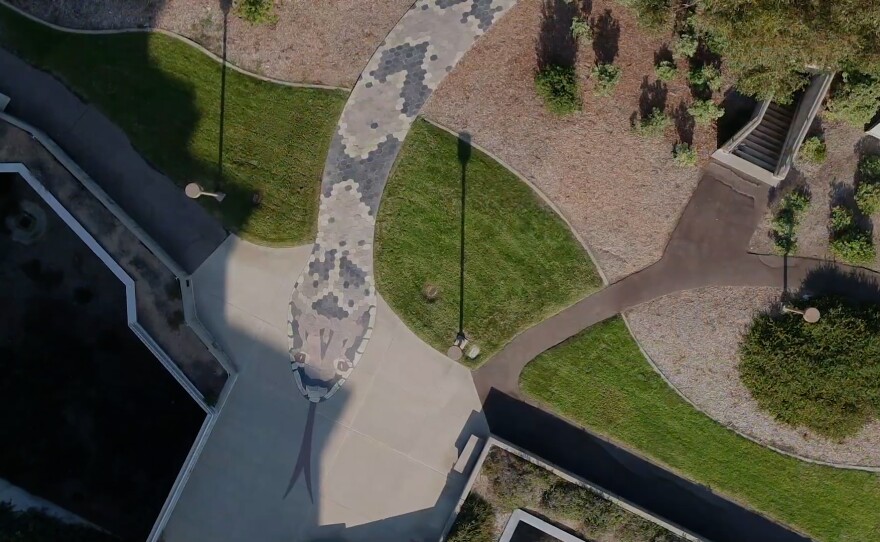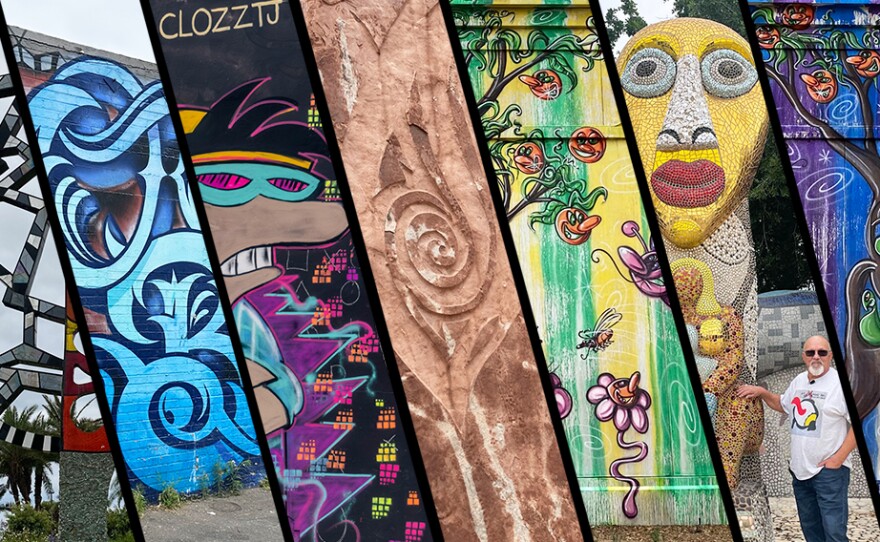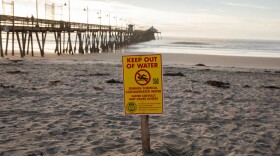Since 1981, the Stuart Collection has commissioned a diverse array of site-specific public art for the UC San Diego campus.
"Its mission is really to enhance the academic and public life of UCSD — to provide students with a bit of respite from their studies and to sort of surprise people, to have art appear in places where you wouldn't usually expect it," said Jessica Berlanga Taylor, director of the Stuart Collection.

Wandering on the UC San Diego campus, you can find a small house hanging precariously off the roof of the engineering building or a flashing light that spells out “What Hath God Wrought” in Morse Code from atop a 199-foot pole or you might trip over a little Buddha overgrown with grass sitting in front of a TV relic.
"It's kind of a graveyard of Buddhas and TVs," Berlanga Taylor said about "Something Pacific" by Nam June Paik. "He was thinking (for example) of the future of the piece in terms of their materials and how they may be affected through time by different conditions of climate ... And he was thinking that in the future, it could look like some sort of archaeological dig that someone would suddenly find."
Exploring the Stuart Collection can be an Indiana Jones adventure in terms of discovering the eclectic art and how some of the art came to be. The collection takes its name from James Stuart DeSilva, who felt art had changed his life and wanted it to do the same for others.

In 1981, Mary Beebe became the first director of the Stuart Collection and Niki De Saint Phalle’s "Sun God" was the first commissioned piece of art.
"I like to say we are not decorating the campus as you would sort of decorate your living room," Beebe said when I interviewed her in 2017.
Instead it was about commissioning artists and bringing them to the campus — to connect with its context and history. Stuart DeSilva donated $1.4 million to create The Stuart Collection.

The result is a breathtakingly eclectic and still-growing collection of public art that is scattered over the campus’ 1,200 acres. The latest and 22nd addition to the collection was unveiled this past April. It is an 800-foot-long stone path of words called "KAHNOP • TO TELL A STORY." The works in the collection range from Alexis Smith’s 560-foot snake slithering up a path, the library and to John Luther Adam’s auditory "Wind Garden."
As project manager, Mathieu Gregoire was the one who had to figure out the logistics of actually installing those works. I spoke with him in 2017 when he was overseeing the installation of the sensors and speakers in the eucalyptus trees where "Wind Garden" is located.
"One way of questioning what art is, is to put art in one's ordinary environment — the environment that we're in as we go to work, as we stroll around, as we have our lunch," Gregoire said. " In other words, you're exposed to artworks that aren't in a place where you go specifically to see art. You're surprised by them. And so, you get to questioning whether it's art or not. And I think that actually there's a tendency for everyone, especially on a university campus, to want to have things explained to them. But art doesn't really work that way. Art — the art in the art experience — is really in the questioning."

Like asking why is there a giant bear on that lawn?
"Well why not?" is the answer Beebe gave. "It's kind of an astounding bear when you think that it's real granite and the whole thing weighs 360,000 pounds."

Beebe said bringing Tim Hawkinson’s "Bear" to life was a challenge that started with finding the torso in an abandoned rock quarry.
"We had to find a torso first, because you can't look for arms and legs until you know what size torso it is," Beebe said.
Then the rocks were brought to campus on an 18-axle truck that was used to transport the space shuttle. It was all worth it when a Boy Scout turned to Beebe to share his opinion of "Bear.".
"'Do you know how cool this is? This is so cool. Do you have any idea how cool this is?' And I was just so pleased," Beebe recalled. "So when someone else asks, 'How come you put a bear out there?' Well, because it strikes awe."

It also engages the students who have dressed "Bear" in a cap and gown, given him heart-shaped glasses for Valentine's day, and made him into Beary Potter.

Berlanga Taylor took over the directorship of the Stuart Collection in 2022 after Beebe had retired. She noted that people sometimes don’t even realize something like "Green Table" is art.
"They're having lunch there, for example, and then their eye will suddenly catch that there's tons of phrases inscribed onto this huge granite green table that have to do with politics and history and feminism and oppression and power," Berlanga Taylor said. "So that has ignited certain debates and conversations between students and faculty."

Some of the art has also ignited controversy. Beebe recalled that Bruce Nauman's "Vices and Virtues" prompted a La Jolla city councilman to say 'If the university is allowed to put lust up here in neon, it will incite infidelity in the community.' and the newspaper called me, and I said there are 14 words. How come he chose 'lust'? He could have chosen 'prudence,' or 'faith,' but he chose 'lust.'"
The complaints were raised because the blinking neon work, alternating the seven virtues with seven vices, was initially planned for the La Jolla Playhouse building on the edge of campus. The art's final installation was done on the interior of campus atop of the Charles Lee Powell Structural Systems Laboratory. So, no complaints from neighbors.

Beebe recounted a comment from a student who accidentally discovered Robert Irwin’s "Two Running Violet V Forms," which has been described as a blue fence, a volleyball net for giants, and even as something rumored to have been designed to capture escaped giraffes from the zoo.
"One student said to me, 'I didn't really know anything about art or whatever, but I saw the blue fence and I thought it might be art!' I thought that's so great in the context of the other art that's around — to wonder why — to think it might be art. So that kind of thing really tickles me," Beebe said.

Public art like this explodes the boundaries of conventional art by making art that you can touch, walk over, walk through or maybe not even notice. And any of those reactions are fine.
"We are trying to provide experiences that people can engage in or not," Beebe said. "It's sort of permission to wonder in a way. It's not about whether you like it or not. It's what do you think somebody's saying?"
Berlanga Taylor agreed:
"That's what's key to public art, (it's) to be able to sort of activate or detonate conversations around what it means to occupy public space and who has access to it — who doesn't. Galleries and museums can still be quite daunting to a lot of people and to a lot of communities. And public art ... tends to be more accessible in that way."
Like Do Ho Suh's "Fallen Star," which sits atop Jacobs Hall and looks like it was picked up by the same twister that lifted Dorothy’s house and dropped it in the Land of Oz. While standing below it, I noticed that almost every person who walked by looked up and took a photo because it catches your eye and captures your imagination.
Beebe described Suh's experience. He arrived in Providence from Korea, and he felt "like he'd been dropped into a whole different new world, and that experience was very profound for him; having to get his balance, having to find out about his surroundings, how to balance his life again. So he thought a lot about the idea of home."
And all that inspired him to create "Fallen Star" for the Stuart Collection.

Through work like Suh's, the Stuart Collection challenges notions about what art can be. It can be epic or tiny, concrete or intangible, permanent or ever changing. But it all exists to tell some kind of story.
"It will be able to tell people in the future a lot of what we went through and thought about as society," Berlanga Taylor said. "Artists are, I think, visionaries ahead of their time, and having access to those ideas and to that knowledge in public form is very valuable.
So head out to UC San Diego for a valuable adventure in public art.
Walking Tour of The Stuart Collection

- Niki de Saint Phalle, Sun God, 1983
- Robert Irwin, Two Running Violet V Forms (1983)
- Richard Fleischner, La Jolla Project (1984)
- Terry Allen, Trees (1986)
- Nam June Paik, Something Pacific (1986)
- Ian Hamilton Finlay, UNDA (1987)
- Bruce Nauman, Vices and Virtues (1988)
- William Wegman, La Jolla Vista View (1988)
- Jackie Ferrara, Terrace (1991)
- Michael Asher, Untitled (1991)
- Alexis Smith, Snake Path (1992)
- Jenny Holzer, Green Table (1992)
- Elizabeth Murray, Red Shoe (1996)
- Kiki Smith, Standing (1998)
- John Baldessari, READ/WRITE/THINK/DREAM (2001)
- Tim Hawkinson, Bear (2005)
- Barbara Kruger, Another (2008)
- Do Ho Suh, Fallen Star (2012)
- John Luther Adams, The Wind Garden (2017)
- Mark Bradford, What Hath God Wrought (2018)
- Alexis Smith, Same Old Paradise (2021)
- Ann Hamilton, KAHNOP • TO TELL A STORY, (2023)
This story is part of an ongoing series about public art in the San Diego region. You can listen to Jessica Berlanga Taylor on Midday Edition and check out the story on "KAHNOP."







